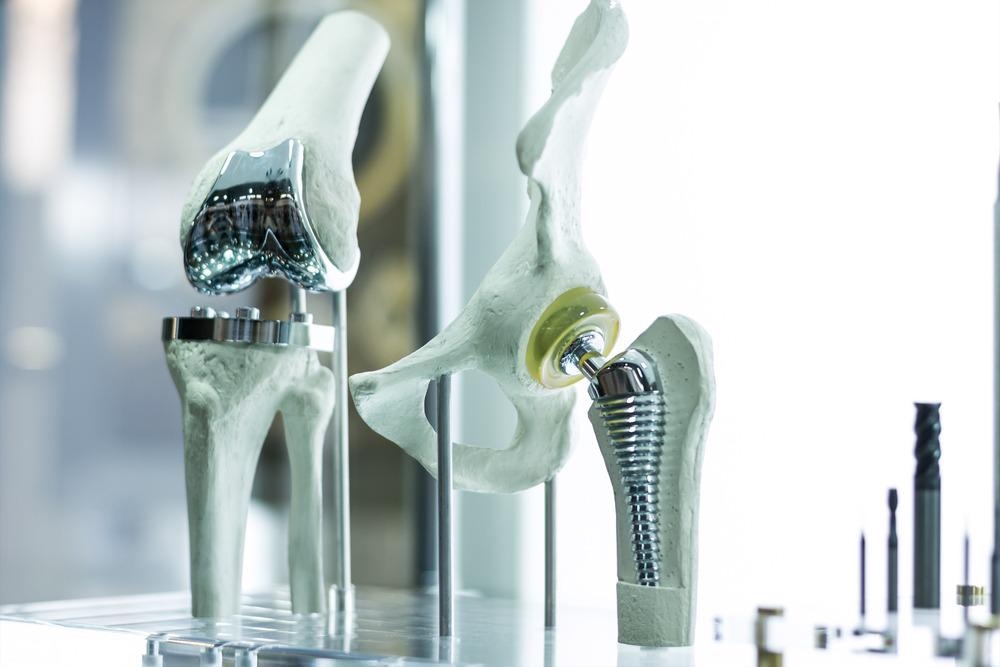Researchers have efficiently modified a TC26 alloy with nanoporous TiO2 to improve the bioactivity and osseointegration of artificial implants. Their research is available as a pre-proof in the journal Colloids and Surfaces A: Physicochemical and Engineering Aspects.

Study: Osteogenic TiO2 composite nano-porous arrays: a favorable platform based on titanium alloys applied in artificial implants. Image Credit: Monstar Studio/Shutterstock.com
Orthopedic with Metallic Implants
Within the orthopedic sector, metallic implants are frequently employed. Despite the huge number of implants in use today, just a few metals are used in the majority of them.
Biomedical metallic materials used in orthopedics, cosmetic procedures, and dentistry, such as molybdenum alloys, stainless steel, and titanium alloys (Ti-based alloy), have sparked widespread interest.
Ti-based alloys are often used as stressed devices in human bodies, such as artificial joints, metal plates for internal fracture repair, bone nails, dental implants, and so on.
Pure titanium alloys have been utilized to overcome common adversities of implants including poor strength and insufficient corrosion resistance.
Benefits of Titanium Alloys as an Implant
Titanium alloys, which were initially developed for the aerospace industry, have attracted interest in the biomedical area because to their low modulus of elasticity, biocompatibility and corrosion resistance.
Due to its beneficial features of high strength, stiffness, fracture toughness, and consistent mechanical behavior as a substitute for hard tissues, metal alloys like titanium remain to be one of the most significant components utilized in orthopedic implantable devices.
Implants made of titanium are intended to last ten years at least.
Current Technology
Rapid osteointegration surrounding artificial implants is essential for tissue regeneration and early infection suppression. It also supports long-lasting therapeutic benefits.
Ti particles created by friction and wear tend to move into nearby arteries, organs, and bone structures after implantation, causing undesirable effects.
TiO2 Implants
Ti-based alloys used in artificial implants have excellent corrosion resistance to the internal human environment, ensuring long-term mechanical characteristics.
The surface properties, including morphology, roughness, chemical composition, and wettability, of biomaterials, are widely acknowledged to play a critical role in the interaction among artificial implant materials and human skeletons.
It can also affect subsequent regulation of cellular and clinical responses after implantation.
New Research on TiO2 with TC26 Alloy Plates
Constant power anodization was used to efficiently modify TC26 alloy plates with nanoporous TiO2.
To create TiO2 nanoporous arrays of composite morphology, the electrochemical characteristics related to primary anodization and secondary anodization are chosen and combined.
The evaluation of the alloy's applicability for artificial implant application involved morphological and chemical characterization, as well as measures of corrosion resistance, wettability, and biocompatibility.
Research Result
According to the findings, the fabricated TiO2 nanoporous arrays demonstrated low cytotoxicity and improved cell adherence and growth compared to pure TC26 alloy plates, prior to heat treatment.
The team demonstrated that TiO2 composite nanoporous arrays offer great potential for bone resorption in artificial implants.
Researchers suggested that nanoporous TiO2 modification and thermal treatment are believed to be essential in establishing a conducive milieu for osseointegration. Pre-osteoblasts stretch their filopodia extensions sufficiently to make more contact with ECM proteins, and this event is linked to cell differentiation.
Continue reading: Medical Applications of Corrosion Resistant Modified Titanium Implants.
Reference
Xu, Z., and Jiang, Z. (2022). Osteogenic TiO2 composite nanoporous arrays: a favorable platform based on titanium alloys applied in artificial implants. Colloids and Surfaces A: Physicochemical and Engineering Aspect. Available at: https://www.sciencedirect.com/science/article/pii/S0927775722000553
Disclaimer: The views expressed here are those of the author expressed in their private capacity and do not necessarily represent the views of AZoM.com Limited T/A AZoNetwork the owner and operator of this website. This disclaimer forms part of the Terms and conditions of use of this website.